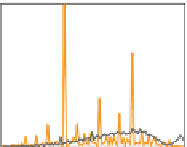Database Reference
In-Depth Information
a
b
c
0.12
0.1
0.2
CNM
HCD
CNM
HCD
CNM
HCD
0.1
0.08
0.15
0.08
0.06
0.06
0.1
0.04
0.04
0.05
0.02
0.02
0
0
0
0
0.1
0.2
0.3
0.4
0.5
0.6
0.7
0.8
0.9
1
0
0.1
0.2
0.3
0.4
0.5
0.6
0.7
0.8
0.9
1
0
0.1
0.2
0.3
0.4
0.5
0.6
0.7
0.8
0.9
1
Conductance
Conductance
Conductance
BIBSONOMY-200K
FLICKR-1M
DELICIOUS-7M
Fig. 5.6 Conductance distribution of the communities detected by CNM and HCD. Across all
three datasets, CNM produces communities with lower (better) conductance values than HCD
Table 5.7 IR performance of CNM and HCD community structures in tag recommendation
BIBSONOMY-200K FLICKR-1M DELICIOUS-7M
CNM HCD CNM HCD CNM HCD
R
T
15,344 15,344 57,206 57,206 56,754 56,754
R
out
15,271 12,440 57,021 51,374 56,115 32,252
R
TP
377 1,547 2,545 14,086 1,250 6,425
P
(%) 2.47 12.44 4.46 27.42 2.23 19.92
R
(%) 2.46 10.08 4.45 24.62 2.20 11.32
F
(%) 2.46 11.14 4.46 25.95 2.21 14.44
P
@1 (%) 2.54 8.48 1.89 14.50 1.63 9.16
P
@5 (%) 2.39 17.48 3.04 26.90 2.36 31.83
The following notation was used:
R
T
denotes the number of correct tags according to the ground
truth,
R
out
the number of tag suggestions made by the recommender,
R
TP
the number of correct
suggestions,
P
,
R
, and
F
denote precision, recall, and F-measure, respectively, and
P
@1 and
P
@5
denote precision at first and fifth, respectively
Finally, we used the derived tag communities in the context of tag recommen-
dation in order to quantify their effect on the IR performance of a community-based
tag recommendation system. More specifically, we created a simple tag community
recommendation scheme, which, based on an input tag, uses the most frequent tags
of its containing community to form the recommendation set. In case more than one
tag are provided as input, the system produces one tag recommendation list (ranked
by tag frequency) for each tag and then aggregates the ranked list by summing the
tag frequencies when of tags belonging to more than one list. Although this
recommendation implementation is very simple, it is suitable for benchmarking
the utility of community structure since it is directly based on it.
The evaluation process was conducted as described in Sect.
5.3.3
with an
additional filtering step applied on the tag assignments of the test set. Out of
those, we removed the tags that (a) did not appear in the training set since it
would be impossible to recommend them and (b) were among the top 5% of the
most frequent tags, since in that case recommending trivial tags (i.e., the most
frequent within the dataset) would be enough to achieve high performance.
Table
5.7
presents a comparison between the IR performance of tag recommen-
dation when using the CNM and HCD tag communities. According to the table,


















































































































Search WWH ::

Custom Search